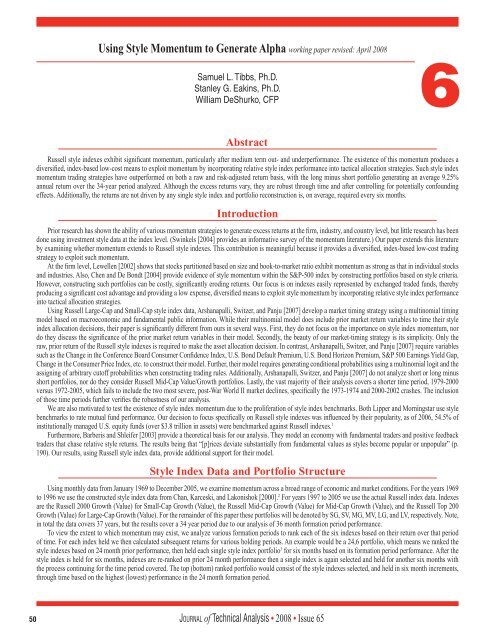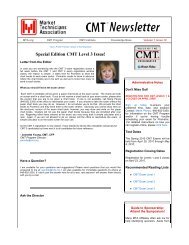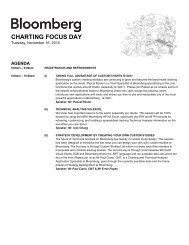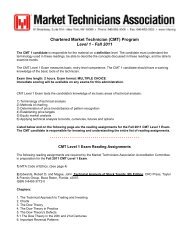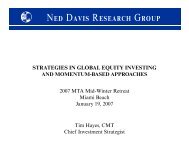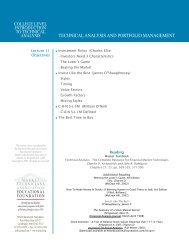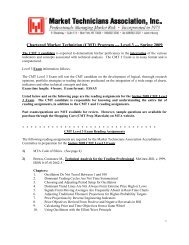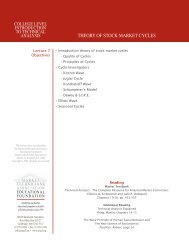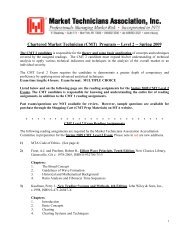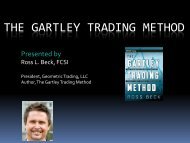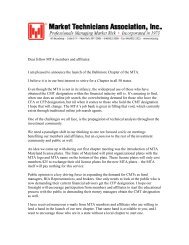Journal of Technical Analysis - Market Technicians Association
Journal of Technical Analysis - Market Technicians Association
Journal of Technical Analysis - Market Technicians Association
Create successful ePaper yourself
Turn your PDF publications into a flip-book with our unique Google optimized e-Paper software.
50<br />
Using Style Momentum to Generate Alpha working paper revised: April 2008<br />
6<br />
Samuel L. Tibbs, Ph.D.<br />
Stanley G. Eakins, Ph.D.<br />
William DeShurko, CFP<br />
Abstract<br />
Russell style indexes exhibit significant momentum, particularly after medium term out- and underperformance. The existence <strong>of</strong> this momentum produces a<br />
diversified, index-based low-cost means to exploit momentum by incorporating relative style index performance into tactical allocation strategies. Such style index<br />
momentum trading strategies have outperformed on both a raw and risk-adjusted return basis, with the long minus short portfolio generating an average 9.25%<br />
annual return over the 34-year period analyzed. Although the excess returns vary, they are robust through time and after controlling for potentially confounding<br />
effects. Additionally, the returns are not driven by any single style index and portfolio reconstruction is, on average, required every six months.<br />
Introduction<br />
Prior research has shown the ability <strong>of</strong> various momentum strategies to generate excess returns at the firm, industry, and country level, but little research has been<br />
done using investment style data at the index level. (Swinkels [2004] provides an informative survey <strong>of</strong> the momentum literature.) Our paper extends this literature<br />
by examining whether momentum extends to Russell style indexes. This contribution is meaningful because it provides a diversified, index-based low-cost trading<br />
strategy to exploit such momentum.<br />
At the firm level, Lewellen [2002] shows that stocks partitioned based on size and book-to-market ratio exhibit momentum as strong as that in individual stocks<br />
and industries. Also, Chen and De Bondt [2004] provide evidence <strong>of</strong> style momentum within the S&P-500 index by constructing portfolios based on style criteria.<br />
However, constructing such portfolios can be costly, significantly eroding returns. Our focus is on indexes easily represented by exchanged traded funds, thereby<br />
producing a significant cost advantage and providing a low expense, diversified means to exploit style momentum by incorporating relative style index performance<br />
into tactical allocation strategies.<br />
Using Russell Large-Cap and Small-Cap style index data, Arshanapalli, Switzer, and Panju [2007] develop a market timing strategy using a multinomial timing<br />
model based on macroeconomic and fundamental public information. While their multinomial model does include prior market return variables to time their style<br />
index allocation decisions, their paper is significantly different from ours in several ways. First, they do not focus on the importance on style index momentum, nor<br />
do they discuss the significance <strong>of</strong> the prior market return variables in their model. Secondly, the beauty <strong>of</strong> our market-timing strategy is its simplicity. Only the<br />
raw, prior return <strong>of</strong> the Russell style indexes is required to make the asset allocation decision. In contrast, Arshanapalli, Switzer, and Panju [2007] require variables<br />
such as the Change in the Conference Board Consumer Confidence Index, U.S. Bond Default Premium, U.S. Bond Horizon Premium, S&P 500 Earnings Yield Gap,<br />
Change in the Consumer Price Index, etc. to construct their model. Further, their model requires generating conditional probabilities using a multinomial logit and the<br />
assigning <strong>of</strong> arbitrary cut<strong>of</strong>f probabilities when constructing trading rules. Additionally, Arshanapalli, Switzer, and Panju [2007] do not analyze short or long minus<br />
short portfolios, nor do they consider Russell Mid-Cap Value/Growth portfolios. Lastly, the vast majority <strong>of</strong> their analysis covers a shorter time period, 1979-2000<br />
versus 1972-2005, which fails to include the two most severe, post-War World II market declines, specifically the 1973-1974 and 2000-2002 crashes. The inclusion<br />
<strong>of</strong> those time periods further verifies the robustness <strong>of</strong> our analysis.<br />
We are also motivated to test the existence <strong>of</strong> style index momentum due to the proliferation <strong>of</strong> style index benchmarks. Both Lipper and Morningstar use style<br />
benchmarks to rate mutual fund performance. Our decision to focus specifically on Russell style indexes was influenced by their popularity, as <strong>of</strong> 2006, 54.5% <strong>of</strong><br />
institutionally managed U.S. equity funds (over $3.8 trillion in assets) were benchmarked against Russell indexes. 1<br />
Furthermore, Barberis and Shleifer [2003] provide a theoretical basis for our analysis. They model an economy with fundamental traders and positive feedback<br />
traders that chase relative style returns. The results being that “[p]rices deviate substantially from fundamental values as styles become popular or unpopular” (p.<br />
190). Our results, using Russell style index data, provide additional support for their model.<br />
Style Index Data and Portfolio Structure<br />
Using monthly data from January 1969 to December 2005, we examine momentum across a broad range <strong>of</strong> economic and market conditions. For the years 1969<br />
to 1996 we use the constructed style index data from Chan, Karceski, and Lakonishok [2000]. 2 For years 1997 to 2005 we use the actual Russell index data. Indexes<br />
are the Russell 2000 Growth (Value) for Small-Cap Growth (Value), the Russell Mid-Cap Growth (Value) for Mid-Cap Growth (Value), and the Russell Top 200<br />
Growth (Value) for Large-Cap Growth (Value). For the remainder <strong>of</strong> this paper these portfolios will be denoted by SG, SV, MG, MV, LG, and LV, respectively. Note,<br />
in total the data covers 37 years, but the results cover a 34 year period due to our analysis <strong>of</strong> 36 month formation period performance.<br />
To view the extent to which momentum may exist, we analyze various formation periods to rank each <strong>of</strong> the six indexes based on their return over that period<br />
<strong>of</strong> time. For each index held we then calculated subsequent returns for various holding periods. An example would be a 24,6 portfolio, which means we ranked the<br />
style indexes based on 24 month prior performance, then held each single style index portfolio 3 for six months based on its formation period performance. After the<br />
style index is held for six months, indexes are re-ranked on prior 24 month performance then a single index is again selected and held for another six months with<br />
the process continuing for the time period covered. The top (bottom) ranked portfolio would consist <strong>of</strong> the style indexes selected, and held in six month increments,<br />
through time based on the highest (lowest) performance in the 24 month formation period.<br />
Jo u r n a l <strong>of</strong> <strong>Technical</strong> <strong>Analysis</strong> • 2008 • Issue 65


